
by Pigeon Patrol | May 25, 2021 | Bird Deterrent Products, Bird Law, Bird Netting, Bird Spikes, Pigeon Control, Pigeon Droppings, Pigeon Patrol's Services
When it comes to birds, there may be more than just avian flu to be worried about. It has been suggested that there are over 60 other diseases that birds and their droppings can carry. The problem is especially worrisome in residential areas, as many of them are airborne and can be transferred to humans just by being around droppings.
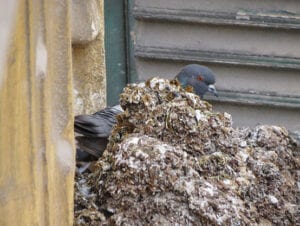
a pigeon bird standing by guano manure
Chicken farms can be fairly easily secured. With a combination of visual scare devices, sonic distress call emitters, ultrasonic disrupters and roost inhibitors other birds shouldn’t be a problem. If farmers just took this preventative action it could help contain the bird flu outbreak a good deal.
- Histoplasmosis is a respiratory disease that may be fatal. It results from a fungus growing in dried bird droppings.
- Candidiasis is a yeast or fungus infection spread by pigeons. The disease affects the skin, the mouth, the respiratory system, the intestines and the urogenital tract, especially the vagina. It is a growing problem for women, causing itching, pain and discharge.
- Cryptococcosis is caused by yeast found in the intestinal tract of pigeons and starlings. The illness often begins as a pulmonary disease and may later affect the central nervous system. Since attics, cupolas, ledges, schools, offices, warehouses, mills, barns, park buildings, signs, etc. are typical roosting and nesting sites, the fungus is apt to found in these areas.
- St. Louis Encephalitis, an inflammation of the nervous system, usually causes drowsiness, headache and fever. It may even result in paralysis, coma or death. St. Louis encephalitis occurs in all age groups, but is especially fatal to persons over age 60. The disease is spread by mosquitoes which have fed on infected house sparrow, pigeons and house finches carrying the Group B virus responsible for St. Louis encephalitis.
- Salmonellosis often occurs as “food poisoning” and can be traced to pigeons, starlings and sparrows. The disease bacteria are found in bird droppings; dust from droppings can be sucked through ventilators and air conditioners, contaminating food and cooking surfaces in restaurants, homes and food processing plants.
- E.coli. Cattle carry E. coli 0157:H7. When birds peck on cow manure, the E. coli go right through the birds and the bird droppings can land on or in a food or water supply.
Besides being direct carriers of disease, nuisance birds are frequently associated with over 50 kinds of ectoparasites, which can work their way throughout structures to infest and bite humans. About two-thirds of these pests may be detrimental to the general health and well-being of humans and domestic animals. The rest are considered nuisance or incidental pests.
A few examples of ectoparasites include:
- Bed bugs (Cimex lectularius) may consume up to five times their own weight in blood drawn from hosts which include humans and some domestic animals. In any extreme condition, victims may become weak and anemic. Pigeons, starlings and house sparrows are known to carry bed bugs.
- Chicken mites (Dermanyssus gallinae) are known carriers of encephalitis and may also cause fowl mite dermatitis and acariasis. While they subsist on blood drawn from a variety of birds, they may also attack humans. They have been found on pigeons, starlings and house sparrows.
- Yellow mealworms (Tenebrio molitor), perhaps the most common beetle parasites of people in the United States, live in pigeon nests. It is found in grain or grain products, often winding up in breakfast cereals, and may cause intestinal canthariasis and hymenolespiasis.
- West Nile Virus while West Nile is technically not transmitted to humans from birds, humans can get infected by the bite of a mosquito who has bitten an infected bird. The obvious lesson is that the fewer birds there are in any given area, the better. This translates into a smaller chance of an infected bird in that area, a smaller chance of a mosquito biting an infected bird and then biting a human.
Pigeon Patrol Products & Services is the leading manufacturer and distributor of bird deterrent (control) products in Canada. Pigeon Patrol products have solved pest bird problems in industrial, commercial, and residential settings since 2000, by using safe and humane bird deterrents with only bird and animal friendly solutions. At Pigeon Patrol, we manufacture and offer a variety of bird deterrents, ranging from Ultra-flex Bird Spikes with UV protection, Bird Netting, 4-S Bird Gel and the best Ultrasonic and audible sound devices on the market today.
Voted Best Canadian wholesaler for Bird Deterrent products ten years in a row.
Contact us at 1- 877– 4– NO-BIRD, (604) 585-9279 or visit our website at www.pigeonpatrol.ca
Pigeon/Pigeon Patrol / Pigeons Roosting / Vancouver Pigeon Control /Bird Spikes / Bird Control / Bird Deterrent / Pigeon Deterrent? Surrey Pigeon Control / Pest /Seagull deterrent / Vancouver Pigeon Blog / Birds Inside Home / Pigeons in the cities / Ice Pigeons/ What to do about pigeons/ sparrows , Damage by Sparrows, How To Keep Raccoons Away, Why Are Raccoons Considered Pests/ De-fence / Pigeon Nesting/ Bird Droppings / Pigeon Dropping/ woodpecker control/ Professional Bird Control Company/ Keep The Birds Away/ Birds/rats/ seagull/pigeon/woodpecker/ dove/sparrow/pidgeon control/pidgeon problem/ pidgeon control/flying rats/ pigeon Problems/ bird netting/bird gel/bird spray/bird nails/ bird guard

by Pigeon Patrol | May 17, 2021 | Bird Netting, Pigeon Patrol's Services, Pigeon Predators, Pigeon Spikes, Pigeons, Pigeons in the News
When pigeons live on our buildings and deface it, it is possible to remove the birds by excluding them (netting) from the area, but we don’t need to kill them. You should make it a priority to clean the area’s they have been since pigeons do carry mites and you don’t want the mites going in your building when the pigeons are gone.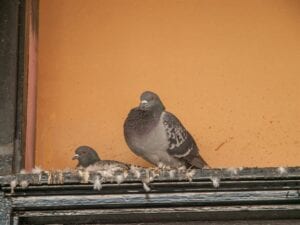
Pigeons are frequently called rats with wings. The term “rats with wings” came from a 1980 play, “Stardust Memories” starring Woody Allen. Allen used the term in the movie and apparently someone with a vested interest in misleading the public decided to use it in a campaign to drum up business for pigeon control. The facts are just the opposite. Yes, there are some diseases that can be transmitted by pigeons, but no more so than any other bird, including such popular pets as parakeets, canaries, etc.
They do have their attributes. During World War I, pigeons carried thousands of messages that saved many hundreds of lives. In World War II pigeons continued to be used. Radios were frequently not working due to damage or when unfavorable terrain rendered them almost useless. Pigeons continued to fly through enemy fire, and amazingly 95% of them completed their missions. One pigeon in particular, named “Cher Ami” was a World War I Carrier Pigeon, one of 600 birds owned and flown by the U.S. Signal Corps. Cher Ami was originally bred by the British Signal Corps. He was transferred to the Americans after the war on Oct. 27, 1918.
Cher Ami delivered 12 important messages within the American sector at Verdun, France. On his last mission, Cher Ami, shot through the breast by enemy fire, managed to return to his loft. A message capsule was found dangling from the ligaments of one of his legs that had also been shattered by enemy fire. The message he carried was from Major Whittlesey’s “Lost Battalion” of the 77th Infantry Division that had been isolated from other American forces. Just a few hours after the message was received, 194 survivors of the battalion were safe behind American lines. Cher Ami was awarded the French “Croix de Guerre” with Palm for his heroic service between the forts of Verdun. He died in 1919 as a result of his battle wounds. Cher Ami was later inducted into the Racing Pigeon Hall of Fame in 1931 and received a gold medal from the Organized Bodies of American Racing Pigeon Fanciers in recognition of his extraordinary service during World War I.
Pigeons continued their valiant service during World War II and the Korean War. The Dickin Medal for Valor, an award only for animals, was given to 31 pigeons in World War II, more than any other animal. (The next closest animals were dogs, with 8 medals).
Source
Pigeon Patrol Products & Services is the leading manufacturer and distributor of bird deterrent (control) products in Canada. Pigeon Patrol products have solved pest bird problems in industrial, commercial, and residential settings since 2000, by using safe and humane bird deterrents with only bird and animal friendly solutions. At Pigeon Patrol, we manufacture and offer a variety of bird deterrents, ranging from Ultra-flex Bird Spikes with UV protection, Bird Netting, 4-S Bird Gel and the best Ultrasonic and audible sound devices on the market today.
Voted Best Canadian wholesaler for Bird Deterrent products ten years in a row.
Contact us at 1- 877– 4– NO-BIRD, (604) 585-9279 or visit our website at www.pigeonpatrol.ca
Pigeon/Pigeon Patrol / Pigeons Roosting / Vancouver Pigeon Control /Bird Spikes / Bird Control / Bird Deterrent / Pigeon Deterrent? Surrey Pigeon Control / Pest /Seagull deterrent / Vancouver Pigeon Blog / Birds Inside Home / Pigeons in the cities / Ice Pigeons/ What to do about pigeons/ sparrows , Damage by Sparrows, How To Keep Raccoons Away, Why Are Raccoons Considered Pests/ De-fence / Pigeon Nesting/ Bird Droppings / Pigeon Dropping/ woodpecker control/ Professional Bird Control Company/ Keep The Birds Away/ Birds/rats/ seagull/pigeon/woodpecker/ dove/sparrow/pidgeon control/pidgeon problem/ pidgeon control/flying rats/ pigeon Problems/ bird netting/bird gel/bird spray/bird nails/ bird guard
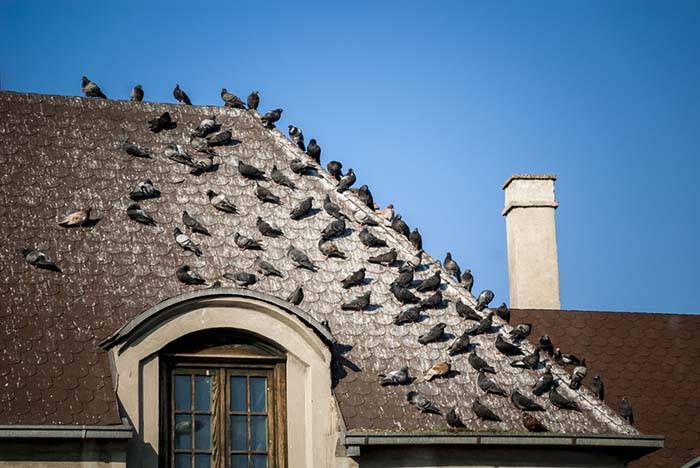
by Pigeon Patrol | May 17, 2021 | Bird Netting, Bird Spikes, Pigeon Control, Pigeon Droppings
Pigeons are easily recognizable by their distinct coloring. With their white-gray rump, iridescent facial feathers and black stripes on their tails and wings, these birds are easy to identify. Pigeons reproduce incredibly quickly, and mating occurs year round. Despite their speedy reproduction rates, pigeons are monogamous creatures that lay one or two eggs at a time, which hatch within 18 days. Baby pigeons are fed “pigeon milk,” or regurgitated food, by both their parents until they are old enough to find food on their own.
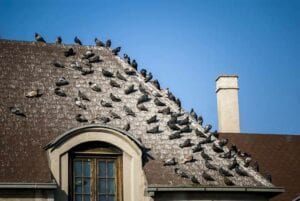
Pigeon Habits
Pigeons prefer grains, but they are not picky when it comes to their meals. Much of their diet comes from humans who drop or spill their food, or place leftovers in open trash cans that pigeons can scavenge. These birds like to hang out on ledges and other narrow areas high above the ground. They like to roost in covered, high areas, and their nests can frequently be found in places like steeples or under bridges.
Pigeon Habitats
Pigeons are true city dwellers who are dependent on humans to provide food, roosting and nesting sites. This is why you often see them gathered around city parks, buildings and bridges. Pigeons are also commonly found around agricultural areas, as well as warehouses, feed mills and grain elevators.
Pigeon Threats
Often called the “rats of the sky,” pigeons can be incredibly problematic. These birds can carry dangerous diseases like cryptococcosis, toxoplasmosis, salmonella, food poisoning and more. Their droppings may also harbor the growth of fungus, which causes histoplasmosis, which can accelerate the aging of structures and statues. Even more alarming, these social birds often serve as unwitting hosts to fleas, lice, mites, ticks and other pests, which can create secondary infestations.
Signs You Have a Pigeon Infestation
The most obvious sign of a pigeon infestation is the presence of many birds, pigeon nests or their droppings.
How To Prevent an Infestation
The best way to prevent pigeons from roosting in or near your house is to make your home undesirable. Remove any and all food they could get access to, place pointy objects on pigeon-friendly surfaces and place nets across open areas.
How to Get Rid of Pigeons
The steps for pigeon removal and prevention are the same: make their living space uninhabitable. Killing pigeons is not effective and it will not root out the source of the problem. Instead, eliminate all food sources and remove their nests and replace them with objects that prevent them from returning.
Source
Pigeon Patrol Products & Services is the leading manufacturer and distributor of bird deterrent (control) products in Canada. Pigeon Patrol products have solved pest bird problems in industrial, commercial, and residential settings since 2000, by using safe and humane bird deterrents with only bird and animal friendly solutions. At Pigeon Patrol, we manufacture and offer a variety of bird deterrents, ranging from Ultra-flex Bird Spikes with UV protection, Bird Netting, 4-S Bird Gel and the best Ultrasonic and audible sound devices on the market today.
Voted Best Canadian wholesaler for Bird Deterrent products ten years in a row.
Contact us at 1- 877– 4– NO-BIRD, (604) 585-9279 or visit our website at www.pigeonpatrol.ca
Pigeon/Pigeon Patrol / Pigeons Roosting / Vancouver Pigeon Control /Bird Spikes / Bird Control / Bird Deterrent / Pigeon Deterrent? Surrey Pigeon Control / Pest /Seagull deterrent / Vancouver Pigeon Blog / Birds Inside Home / Pigeons in the cities / Ice Pigeons/ What to do about pigeons/ sparrows , Damage by Sparrows, How To Keep Raccoons Away, Why Are Raccoons Considered Pests/ De-fence / Pigeon Nesting/ Bird Droppings / Pigeon Dropping/ woodpecker control/ Professional Bird Control Company/ Keep The Birds Away/ Birds/rats/ seagull/pigeon/woodpecker/ dove/sparrow/pidgeon control/pidgeon problem/ pidgeon control/flying rats/ pigeon Problems/ bird netting/bird gel/bird spray/bird nails/ bird guard
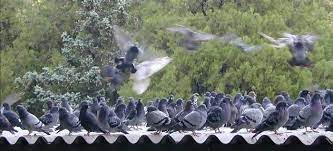
by Pigeon Patrol | May 10, 2021 | Bird Deterrent Products, Bird Law, Bird Netting, Bird Spikes, Columbidae, Pigeon Predators, Pigeon Spikes
Most of us love having backyard birds to watch and to feed. The music of songbirds is a sure sign of spring. On the other hand, bird damage to lawns can be extensive. If you’re finding small holes in your grass and you see a lot of birds around, the damage is probably caused by birds foraging for food. There are some ways you can keep birds from digging up lawn and grass. Read on to learn more.
Why are Birds Digging up my Lawn?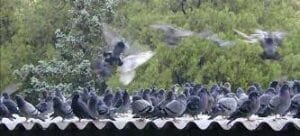
It’s not hard to identify bird damage to lawns. If you see a lot of birds in your yard and you find small, about one-inch (2.5-cm.) holes in the turf, it’s most likely bird-related damage. What are birds digging for in your lawn? The phenomenon of birds digging holes in lawns has an easy explanation: food. They’re looking for tasty snacks, so if you’re seeing a lot of bird damage, it means you have an insect problem. Basically, your lawn is the best restaurant around because it has so many bugs. Birds are simply foraging for grubs, worms, and insects. The good news about this is that the grubs and insects will actually do more damage to your lawn than the birds will, and the birds are helping you control the population.
How to Keep Birds from Digging up Lawn
If you want to avoid the bird damage of small holes all over your lawn, you have to get rid of the insect pests. To get rid of your bug problem, invest in a pesticide, preferably something natural. You can either have it applied by a professional lawn company or you can do it yourself. It is important to time the application. If you have grubs, for instance, you need to apply in late spring or early summer. It’s also important to time application to avoid harming the birds. Apply the pesticide in late afternoon so it will be dry by the next morning when the birds reappear to search for breakfast. If you prefer not to have birds at all around your property, there is little you can do but you can try using a few scare tactics that may keep the birds away.
Source
Pigeon Patrol Products & Services is the leading manufacturer and distributor of bird deterrent (control) products in Canada. Pigeon Patrol products have solved pest bird problems in industrial, commercial, and residential settings since 2000, by using safe and humane bird deterrents with only bird and animal friendly solutions. At Pigeon Patrol, we manufacture and offer a variety of bird deterrents, ranging from Ultra-flex Bird Spikes with UV protection, Bird Netting, 4-S Bird Gel and the best Ultrasonic and audible sound devices on the market today.
Voted Best Canadian wholesaler for Bird Deterrent products ten years in a row.
Contact us at 1- 877– 4– NO-BIRD, (604) 585-9279 or visit our website at www.pigeonpatrol.ca
Pigeon/Pigeon Patrol / Pigeons Roosting / Vancouver Pigeon Control /Bird Spikes / Bird Control / Bird Deterrent / Pigeon Deterrent? Surrey Pigeon Control / Pest /Seagull deterrent / Vancouver Pigeon Blog / Birds Inside Home / Pigeons in the cities / Ice Pigeons/ What to do about pigeons/ sparrows , Damage by Sparrows, How To Keep Raccoons Away, Why Are Raccoons Considered Pests/ De-fence / Pigeon Nesting/ Bird Droppings / Pigeon Dropping/ woodpecker control/ Professional Bird Control Company/ Keep The Birds Away/ Birds/rats/ seagull/pigeon/woodpecker/ dove/sparrow/pidgeon control/pidgeon problem/ pidgeon control/flying rats/ pigeon Problems/ bird netting/bird gel/bird spray/bird nails/ bird guard
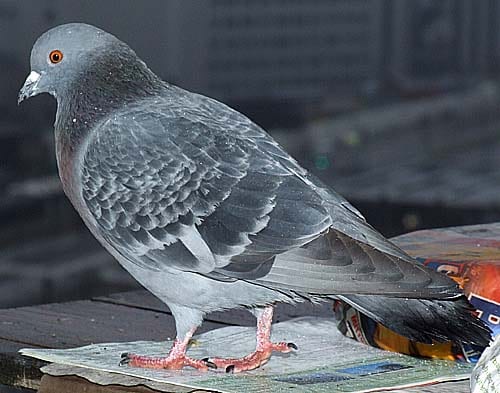
by Pigeon Patrol | May 3, 2021 | Animal Deterrent Products, Bird Deterrent Products, Bird Netting, Bird Spikes, history of pigeons, Pigeon Control, Pigeon Patrol's Services, Pigeon Spikes
Need pigeon removal in your hometown?
Pigeons are a determined bird, doggedly living near humans because of the ample food supply. These birds are indiscriminate eliminators of waste, leaving liquid splatters of dropping anywhere they travel. Their lack of concern for cleanliness extends into their everyday activities, and water contamination has been traced back to pigeon carcasses and feces in water towers near roosting sites. The waste from these birds, which are most commonly seen in urban areas, is very corrosive. Concrete, limestone and metal all suffer from the ill-effects of pigeon droppings. In cities, constant cleanup alone costs thousands of dollars.
Because of the homing ability of pigeons, there are difficulties with relocation. This species of bird was once used as a messenger between civilizations, finding their way over hundreds and thousands of miles. The only way to get rid of pigeons is to discourage them and prevent them from frequenting undesired locations. There are a number of ways to accomplish this, some proven to show more success than others. Information about pigeon trapping – analysis and methods for how to trap.
Unsuccessful methods of pigeon control deal mostly with predator fear. Plastic owls are a favorite of the public when, in reality, the fake predator appears as just that—fake. A pigeon will not be any more leery of an unmoving owl than it would an unmoving human. Pigeons are largely unaffected by unpleasant smells, though it has recently been proven that their homing ability is based on scent mapping and not electromagnetic fields. Sounds are another flop when it comes to pigeon control. Ultrasonic sound emitters may very well produce noises humans can’t hear, but rarely are those sounds ‘annoying’ to birds. If a pigeon can put up with all the noise congestion in a busy city, some random sounds from an ultrasonic radio aren’t going to bother it.
The most practical ways to get rid of pigeons is to convince them that they do not or cannot stay near your home or business. Any ledge can be a roosting site. By installing pigeon nets, bird spikes or electric shockers, pigeons will be less inclined to settle on those surfaces. Nets and spikes prevent roosting all together. Electric strips may be difficult to install at higher locations, but many brands offer solar power and require little maintenance. Electric strips do require more attention than netting and are often more expensive. If your building has smaller sections of roof, bird “spiders” are useful instruments. The wire device resembles a sprinkler in design with thin lines of arced metal extending outward from a central location. These wires are loose and are not strong enough to support the weight of a bird.
Information about how to keep pigeons away – prevention techniques.
There is something to be said for determination, too. Even though most scare tactics do not work on pigeons, harassment techniques can prove beneficial if done frequently and without fail. If pigeons have taken over your yard, letting your dog out will chase them away. Yes, they will come back when the dog is gone, but if this scenario is repeated often enough the pigeons will learn that your yard is not the easiest place to visit. When it comes to opportunistic birds, life is all about easy.
Some towns and cities have experimented with employing the use of falcons to control pigeon populations. The benefit to using birds of prey is that they often keep the pigeons moving, preventing any one roosting area to become long-term. Unfortunately, falcons cannot eliminate a large enough number of the nuisance birds to make a noticeable difference without becoming a nuisance bird themselves.
Pigeons are products of their environment. If they were not deliberately fed in parks and on streets a decline in their nuisance behaviors would be seen. These birds can live on naturally occurring food sources. Unfortunately, it is the poor sanitation habits of people that keep these animals desiring our leftovers. If pigeons have overrun your home, be sure that all garbage and compost is carefully disposed of. You may not be able to control the habits of the neighbors on your block, but you can make your house that much more uninviting by following good hygiene habits.
Pigeon Information & Facts
Pigeon Appearance: Pigeons are robust birds with short necks, usually gray in color with a faint iridescence to their feathers. They have a characteristic back and forth rhythm to their head. This bobbing is a mechanism that allows the birds to focus their vision and perceive depth. Pigeons have duplicate black bands on each wing, but the coloration on the main part of the body can vary. Their feet are suited for perching on ledges and high peaks. The beak of the pigeon is medium in both length and width, ideal for pulling apart bread, picking up small food pieces, or fishing spiders out of cracks.
Pigeon Habitat and Behavior: Pigeons are most often seen in cities. This habitat preference is largely due to the surplus of food available and the high roosting opportunities. Pigeons are fond of the water towers on tall buildings, often building messy nests on the rim. For this reason, most cities require water towers be completely sealed to prevent the birds or their waste from contaminating the water supply. A pigeon will nest almost anywhere and will often do so with many others of its kind. A roost can be made atop any vertical surface. Pigeons are known in invade gutters, ducts, air conditioners, attics, warehouses, and drains. They are not overly concerned with sanitary conditions and will utilize any vertical object in any location for their purposes.
Pigeons are also very food-driven. This problem has been made serious by the continued, deliberate feeding of the birds in urban areas. The birds have little fear of humans and will often converge around people in parks and near restaurants. Pigeon feeding is a common hobby of many city-goers, yet another reason for the lack of caution around humans.
Egg laying can take place as often as every other month. Courtship between the male and the female is brief, and the resulting egg clutch usually only contains two eggs. An abundance of pigeons will result in quick overpopulation, regardless of how many eggs are laid per pair. Some cites have sought population control by replacing viable eggs with fake or unfertilized eggs. This tactic may be effective short-term, but pigeons will lay another clutch once the original appears unproductive.
Pigeon Diet: Pigeons will scavenge for almost any type of grain-based food source. The habit of city restaurants discarding stale bread into parks increases the role this type of food plays in the pigeon diet. In nature, the birds eat insects, berries, seeds, grains, and spiders.
Pigeon Nuisance Concerns: Pigeons are not as bold as some species of birds adapted to living off human leftovers. The major concern when it comes to this species centers on its roosting habits. Pigeons most often roost in number. They are not a sanitary bird, often eliminating waste in their own nests, and living on top of the bodies of their own kind. Pigeon waste is caustic and will do permanent damage to stone and concrete. In many cities, water contamination due to pigeons and their droppings has been a major concern. Because these birds pool around areas with a high opportunity for food (such as restaurants), there is a logical concern for public health.
Pigeon Diseases: The most common zoonotic disease associated with pigeons is called histoplasmosis. This disease is caused by a fungal infection facilitated by the dried powder of pigeon feces. People with compromised immune systems should also be wary of cryptococcosis, another fungal infection affecting only those without healthy defenses. Psittacosis, more commonly transmitted by exotic birds, has been reported in larger cities. These illnesses present with flu-like symptoms, making diagnosis and treatment difficult unless the disease is well underway.
This site is intended to provide pigeon education and information, so that you can make an informed decision if you need to deal with a pigeon problem. This site provides many pigeon control articles and strategies, if you wish to attempt to solve the problem yourself. If you are unable to do so, which is likely with many cases of pigeon removal, please go to the home page and click the USA map, where I have wildlife removal experts listed in over 500 cites and towns, who can properly help you with your nuisance pigeon.
Pigeon Patrol Products & Services is the leading manufacturer and distributor of bird deterrent (control) products in Canada. Pigeon Patrol products have solved pest bird problems in industrial, commercial, and residential settings since 2000, by using safe and humane bird deterrents with only bird and animal friendly solutions. At Pigeon Patrol, we manufacture and offer a variety of bird deterrents, ranging from Ultra-flex Bird Spikes with UV protection, Bird Netting, 4-S Bird Gel and the best Ultrasonic and audible sound devices on the market today.
Voted Best Canadian wholesaler for Bird Deterrent products ten years in a row.
Contact us at 1- 877– 4– NO-BIRD, (604) 585-9279 or visit our website at www.pigeonpatrol.ca
Pigeon/Pigeon Patrol / Pigeons Roosting / Vancouver Pigeon Control /Bird Spikes / Bird Control / Bird Deterrent / Pigeon Deterrent? Surrey Pigeon Control / Pest /Seagull deterrent / Vancouver Pigeon Blog / Birds Inside Home / Pigeons in the cities / Ice Pigeons/ What to do about pigeons/ sparrows , Damage by Sparrows, How To Keep Raccoons Away, Why Are Raccoons Considered Pests/ De-fence / Pigeon Nesting/ Bird Droppings / Pigeon Dropping/ woodpecker control/ Professional Bird Control Company/ Keep The Birds Away/ Birds/rats/ seagull/pigeon/woodpecker/ dove/sparrow/pidgeon control/pidgeon problem/ pidgeon control/flying rats/ pigeon Problems/ bird netting/bird gel/bird spray/bird nails/ bird guard

by Pigeon Patrol | Feb 24, 2021 | Bird Deterrent Products, Bird Netting, Bird Spikes, Doves, Pigeon Control, Pigeon Spikes
![Building Product: No Knot Bird Netting - [10203b8] | ARCAT](https://www.arcat.com//photos/birdbgon/132024.jpg)
Why You Should Get Bird Netting
Are you a business owner or property owner that has a bird problem on your premises? Then this is the blog for you!
Here are reasons you should get bird netting!
Bird netting is set up to prevent birds from reaching certain areas, encouraging them to move on to an easier roosting place. Netting can keep birds off windowsills, rooftops, away from your ventilation and roof top air conditioning units. It can take a professional to know just where to place the netting so that it will be the most productive and the least noticeable for customers.
The benefits of using Bird Netting?
- Netting is a great solution against pretty much any type of birds, especially the likes of pigeons and gulls, sparrows and starlings, who are known to cause problems
- Bird netting is highly versatile and can be fitted to pretty much any size that you need to cover
- Bird netting protect structures
- Netting is environmentally safe and can withstand a wide range of environmental conditions
- Netting can last many years
- Netting is virtually invisible when installed correctly
Bird netting or anti-bird netting is a form of bird pest control. It is a net used to prevent birds from reaching certain areas.
Bird protection netting comes in a variety of shapes and forms, The most common is a small mesh (1 or 2 cm squares) either extruded and bi-oriented polypropylene or woven polyethylene.
The color most used is black (as the carbon black UV inhibitor offers the best protection against solar rays), but also bird netting may be available in other colors like white (usually white netting is woven or knitted and has an even smaller mesh size as it will serve as a double purpose anti-hail net for the protection of fruits during summer hail storms or late spring during flowering) or green (usually used in home gardening and mostly sold at retail outlets for the DIY farmers).
Source
Pigeon Patrol Products & Services is the leading manufacturer and distributor of bird deterrent (control) products in Canada. Pigeon Patrol products have solved pest bird problems in industrial, commercial, and residential settings since 2000, by using safe and humane bird deterrents with only bird and animal friendly solutions. At Pigeon Patrol, we manufacture and offer a variety of bird deterrents, ranging from Ultra-flex Bird Spikes with UV protection, Bird Netting, 4-S Gel and the best Ultrasonic and audible sound devices on the market today.
Contact us at 1- 877– 4– NO-BIRD, (604) 585-9279 or visit our website at www.pigeonpatrol.ca
Pigeon / Pigeon Patrol / Pigeons Roosting / Vancouver Pigeon Patrol / Bird Control / Surrey Pigeon Control / Pest / Vancouver Pigeon Blog / Birds Inside Home / Pigeons in the cities / Ice Pigeons/ What to do about pigeons/ most common types of sparrows , Damages Caused by Sparrows, How To Keep Raccoons Away, Why Are Raccoons Considered Pests?de-fence, Pigeon Nesting and Breeding Patterns and Behavior What Do I Do With a Bird Trapped in My Wall? Professional Bird Control Company Keep The Birds Away From Your Business Why Are Raccoons Considered Pests?


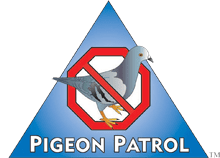







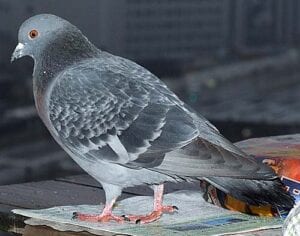

![Building Product: No Knot Bird Netting - [10203b8] | ARCAT](https://www.arcat.com//photos/birdbgon/132024.jpg)